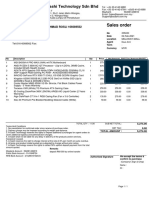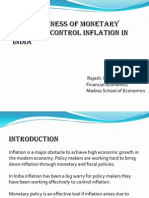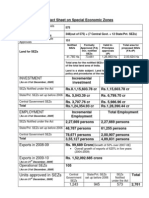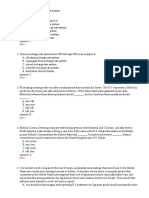A Blank Nafta Coo
A Blank Nafta Coo
Uploaded by
Ana Patricia Castro MendozaCopyright:
Available Formats
A Blank Nafta Coo
A Blank Nafta Coo
Uploaded by
Ana Patricia Castro MendozaOriginal Description:
Copyright
Available Formats
Share this document
Did you find this document useful?
Is this content inappropriate?
Copyright:
Available Formats
A Blank Nafta Coo
A Blank Nafta Coo
Uploaded by
Ana Patricia Castro MendozaCopyright:
Available Formats
OMB No.
1651-0098
Exp. 03-31-2012
See back of form for Paperwork Reduction Act Notice.
DEPARTMENT OF HOMELAND SECURITY
U.S. Customs and Border Protection
NORTH AMERICAN FREE TRADE AGREEMENT
CERTIFICATE OF ORIGIN
Please print or type
19 CFR 181.11, 181.22
1. EXPORTER NAME AND ADDRESS
INTERMETRO INDUSTRIES CORPORATION
651 NORTH WASHINGTON STREET
WILKES-BARRE, PA 18705 U.S.A.
TAX IDENTIFICATION NUMBER:
2. BLANKET PERIOD
FROM
TO
24-0836974
3. PRODUCER NAME AND ADDRESS
01/02/2017
12/31/2017
4. IMPORTER NAME AND ADDRESS
AVAILABL TO CUSTOMS UPON REQUEST
VARIOUS
TAX IDENTIFICATION NUMBER:
TAX IDENTIFICATION NUMBER:
6.
8.
7.
HS TARIFF
PREFERENCE PRODUCER
CLASSIFICATION
CRITERION
NUMBER
5.
DESCRIPTION OF GOOD(S)
9.
NET COST
10.
COUNTRY
OF ORIGIN
NO MX
NO(3)
I CERTIFY THAT:
THE INFORMATION ON THIS DOCUMENT IS TRUE AND ACCURATE AND I ASSUME THE RESPONSIBILITY FOR PROVING SUCH
REPRESENTATIONS. I UNDERSTAND THAT I AM LIABLE FOR ANY FALSE STATEMENTS OR MATERIAL OMISSIONS MADE ON OR IN
CONNECTION WITH THIS DOCUMENT;
I AGREE TO MAINTAIN AND PRESENT UPON REQUEST, DOCUMENTATION NECESSARY TO SUPPORT THIS CERTIFICATE, AND TO INFORM, IN
WRITING, ALL PERSONS TO WHOM THE CERTIFICATE WAS GIVEN OF ANY CHANGES THAT COULD AFFECT THE ACCURACY OR VALIDITY OF
THIS CERTIFICATE;
THE GOODS ORIGINATED IN THE TERRITORY OF ONE OR MORE OF THE PARTIES, AND COMPLY WITH THE ORIGIN REQUIREMENTS SPECIFIED
FOR THOSE GOODS IN THE NORTH AMERICAN FREE TRADE AGREEMENT AND UNLESS SPECIFICALLY EXEMPTED IN ARTICLE 411 OR ANNEX
401, THERE HAS BEEN NO FURTHER PRODUCTION OR ANY OTHER OPERATION OUTSIDE THE TERRITORIES OF THE PARTIES; AND
THIS CERTIFICATE CONSISTS OF
PAGES, INCLUDING ALL ATTACHMENTS.
11a. AUTHORIZED SIGNATURE
11b. COMPANY
INTERMETRO INDUSTRIES CORPORATION
11d. TITLE
11c. NAME (Print or Type)
11.
YI WAN
11e. DATE (MM/DD/YYYY)
01/02/2017
INTERNATIONAL TRADE MANAGER
11f.
TELEPHONE
NUMBER
(Voice)
(Facsimile)
570-706-4352
570-824-5346
CBP Form 434 (04/97)
PAPERWORK REDUCTION ACT NOTICE: This information is needed to carry
out the terms of the North American Free Trade Agreement (NAFTA). NAFTA
requires that, upon request, an importer must provide CBP with proof of the
exporters written certification of the origin of the goods. The certification is
essential to substantiate compliance with the rules of origin under the
Agreement. You are required to give us this information to obtain a benefit.
The estimated average burden associated with this collection of information is
15 minutes per respondent or recordkeeper depending on individual
circumstances. Comments concerning the accuracy of this burden estimate and
suggestions for reducing this burden should be directed to U.S. Customs and
Border Protection, Information Services Branch, Washington, DC 20229, and to
the Office of Management and Budget, Paperwork Reduction Project
(1651-0098), Washington DC 20503.
NORTH AMERICAN FREE TRADE AGREEMENT CERTIFICATE OF ORIGIN INSTRUCTIONS
For purposes of obtaining preferential tariff treatment, this document must be completed legibly and in full by the exporter and be
in the possession of the importer at the time the declaration is made. This document may also be completed voluntarily by the
producer for use by the exporter. Please print or type:
FIELD 1:
FIELD 2:
FIELD 3:
FIELD 4:
FIELD 5:
FIELD 6:
FIELD 7:
State the full legal name, address (including country) and legal tax identification number of the exporter. Legal taxation number is: in Canada,
employer number or importer/exporter number assigned by Revenue Canada; in Mexico, federal taxpayer's registry number (RFC); and in the
United States, employer's identification number or Social Security Number.
Complete field if the Certificate covers multiple shipments of identical goods as described in Field #5 that are imported into a NAFTA country for a
specified period of up to one year (the blanket period). "FROM" is the date upon which Certificate becomes applicable to the good covered by the
blanket Certificate (it may be prior to the date of signing this Certificate). "TO" is the date upon which the blanket period expires. The importation
of a good for which preferential treatment is claimed based on this Certificate must occur between these dates.
State the full legal name, address (including country) and legal tax identification number, as defined in Field #1, of the producer. If more than one
producer's good is included on the Certificate, attach a list of additional producers, including the legal name, address (including country) and legal
tax identification number, cross-referenced to the good described in Field #5. If you wish this information to be confidential, it is acceptable to state
"Available to CBP upon request". If the producer and the exporter are the same, complete field with "SAME". If the producer is unknown, it is
acceptable to state "UNKNOWN".
State the full legal name, address (including country) and legal tax identification number, as defined in Field #1, of the importer. If the importer is
not known, state "UNKNOWN"; if multiple importers, state "VARIOUS".
Provide a full description of each good. The description should be sufficient to relate it to the invoice description and to the Harmonized System
(H.S.) description of the good. If the Certificate covers a single shipment of a good, include the invoice number as shown on the commercial
invoice. If not known, indicate another unique reference number, such as the shipping order number.
For each good described in Field #5, identify the H.S. tariff classification to six digits. If the good is subject to a specific rule of origin in Annex
401 that requires eight digits, identify to eight digits, using the H.S. tariff classification of the country into whose territory the good is imported.
For each good described in Field #5, state which criterion (A through F) is applicable. The rules of origin are contained in Chapter Four and
Annex 401. Additional rules are described in Annex 703.2 (certain agricultural goods), Annex 300-B, Appendix 6 (certain textile goods) and Annex
308.1 (certain automatic data processing goods and their parts). NOTE: In order to be entitled to preferential tariff treatment, each good
must meet at least one of the criteria below.
Preference Criteria
A
B
E
F
FIELD 8:
FIELD 9:
FIELD 10:
FIELD 11:
The good is "wholly obtained or produced entirely" in the territory of one or more of the NAFTA countries as referenced in Article 415. Note: The
purchase of a good in the territory does not necessarily render it "wholly obtained or produced". If the good is an agricultural good, see
also criterion F and Annex 703.2. (Reference: Article 401(a) and 415)
The good is produced entirely in the territory of one or more of the NAFTA countries and satisfies the specific rule of origin, set out in Annex 401,
that applies to its tariff classification. The rule may include a tariff classification change, regional value-content requirement, or a combination
thereof. The good must also satisfy all other applicable requirements of Chapter Four. If the good is an agricultural good, see also criterion F and
Annex 703.2. (Reference: Article 401(b))
The good is produced entirely in the territory of one or more of the NAFTA countries exclusively from originating materials. Under this criterion, one
or more of the materials may not fall within the definition of "wholly produced or obtained", as set out in article 415. All materials used in the
production of the good must qualify as "originating" by meeting the rules of Article 401(a) through (d). If the good is an agricultural good, see also
criterion F and Annex 703.2. Reference: Article 401(c).
Goods are produced in the territory of one or more of the NAFTA countries but do not meet the applicable rule of origin, set out in Annex 401,
because certain non-originating materials do not undergo the required change in tariff classification. The goods do nonetheless meet the regional
value-content requirement specified in Article 401(d). This criterion is limited to the following two circumstances:
1.
The good was imported into the territory of a NAFTA country in an unassembled or disassembled form but was classified as an assembled
good, pursuant to H.S. General Rule of Interpretation 2(a), or
2.
The good incorporated one or more non-originating materials, provided for as parts under the H.S., which could not undergo a change in tariff
classification because the heading provided for both the good and its parts and was not further subdivided into subheadings, or the
subheading provided for both the good and its parts and was not further subdivided.
NOTE: This criterion does not apply to Chapters 61 through 63 of H.S. (Reference: Article 401(d))
Certain automatic data processing goods and their parts, specified in Annex 308.1, that do not originate in the territory are considered originating
upon importation into the territory of a NAFTA country from the territory of another NAFTA country when the most-favored-nation tariff rate of the
good conforms to the rate established in Annex 308.1 and is common to all NAFTA countries. (Reference: Annex 308.1)
The good is an originating agricultural good under preference criterion A, B, or C above and is not subject to a quantitative restriction in the
importing NAFTA country because it is a "qualifying good" as defined in Annex 703.2, Section A or B (please specify). A good listed in Appendix
703.2B.7 is also exempt from quantitative restrictions and is eligible for NAFTA preferential tariff treatment if it meets the definition of "qualifying
good" in Section A of Annex 703.2. NOTE 1: This criterion does not apply to goods that wholly originate in Canada or the United States
and are imported into either country. NOTE 2: A tariff rate quota is not a quantitative restriction.
For each good described in Field #5, state "YES" if you are the producer of the good. If you are not the producer of the good, state "NO" followed
by (1), (2), or (3), depending on whether this certificate was based upon: (1) your knowledge of whether the good qualifies as an originating good;
(2) your reliance on the producer's written representation (other than a Certificate of Origin) that the good qualifies as an originating good; or (3) a
completed and signed Certificate for the good, voluntarily provided to the exporter by the producer.
For each good described in field #5, where the good is subject to a regional value content (RVC) requirement, indicate "NC" if the RVC is
calculated according to the net cost method; otherwise, indicate "NO". If the RVC is calculated over a period of time, further identify the beginning
and ending dates (MM/DD/YYYY) of that period. (Reference: Article 402.1, 402.5).
Identify the name of the country ("MX" or "US" for agricultural and textile goods exported to Canada; "US" or "CA" for all goods exported to Mexico;
or "CA" or "MX" for all goods exported to the United States) to which the preferential rate of CBP duty applies, as set out in Annex 302.2, in
accordance with the Marking Rules or in each party's schedule of tariff elimination.
For all other originating goods exported to Canada, indicate appropriately "MX" or "US" if the goods originate in that NAFTA country, within the
meaning of the NAFTA Rules of Origin Regulations, and any subsequent processing in the other NAFTA country does not increase the transaction
value of the goods by more than seven percent; otherwise indicate "JNT" for joint production. (Reference: Annex 302.2)
This field must be completed, signed, and dated by the exporter. When the Certificate is completed by the producer for use by the exporter, it must
be completed, signed, and dated by the producer. The date must be the date the Certificate was completed and signed.
CBP Form 434 (04/97)(Back)
You might also like
- International Economics 9th Edition Appleyard Test BankDocument10 pagesInternational Economics 9th Edition Appleyard Test Banka159411610100% (1)
- Asashi Sales Order - 3 7Document1 pageAsashi Sales Order - 3 7syahmiNo ratings yet
- Case Kodak Antidumping Disputes With Fuji PDFDocument1 pageCase Kodak Antidumping Disputes With Fuji PDFHITESH MAKHIJANo ratings yet
- Role of RBI in Banking Sector in IndiaDocument17 pagesRole of RBI in Banking Sector in IndiaArunav Guha RoyNo ratings yet
- Specimen Copy: Pharmaceuticals Export Promotion Council of IndiaDocument1 pageSpecimen Copy: Pharmaceuticals Export Promotion Council of IndiaMasfiyah NurjanahNo ratings yet
- SalesOrd 53865 From Sizto Tech Corporation 4392 PDFDocument1 pageSalesOrd 53865 From Sizto Tech Corporation 4392 PDFwzuniniNo ratings yet
- 87-1Document2 pages87-1Ganesh MurthyNo ratings yet
- DGF - (S) Frenzy Creative LTD (C) Distribuidora Andesfilms Sa - v566518 - Commercial InvoiceDocument1 pageDGF - (S) Frenzy Creative LTD (C) Distribuidora Andesfilms Sa - v566518 - Commercial Invoicenelma karlyn arteaga valdiviaNo ratings yet
- Sales Order: TotalDocument1 pageSales Order: TotalMauricio GonzálezNo ratings yet
- Po 84 202003070 0 Us PDFDocument3 pagesPo 84 202003070 0 Us PDFQueiroz PortorrealNo ratings yet
- Sold-To Party Address Information: Sales Order DetailsDocument1 pageSold-To Party Address Information: Sales Order Detailsshakilmagura9424No ratings yet
- Intek Tapes Pvt. LTD.: Packing ListDocument1 pageIntek Tapes Pvt. LTD.: Packing Listlakshmi14101981No ratings yet
- PWPL Po 1581502012 PDFDocument1 pagePWPL Po 1581502012 PDFAlexa BlissNo ratings yet
- SPB - Sim2 Doc4 - GSPDocument1 pageSPB - Sim2 Doc4 - GSPShashankNo ratings yet
- NOA - CNCAPLC - Notice - of - Arrival - SAN - GIORGIO - 1CP6OW1NC - 16800743623211066758Document2 pagesNOA - CNCAPLC - Notice - of - Arrival - SAN - GIORGIO - 1CP6OW1NC - 16800743623211066758nikkoelbao96No ratings yet
- Purchase Order: QuantityDocument2 pagesPurchase Order: QuantityNhan NguyentrongNo ratings yet
- Terms and ConditionDocument3 pagesTerms and ConditionAna ClarkNo ratings yet
- Inv P List Jakarta PDFDocument2 pagesInv P List Jakarta PDFirfan dadiNo ratings yet
- Commercial Invoice and Packing List-SuperplantDocument2 pagesCommercial Invoice and Packing List-Superplanthermanto doankNo ratings yet
- MJN Po 9000661239Document1 pageMJN Po 9000661239Yanika IemNo ratings yet
- AttachDocument2 pagesAttachAnkush SainiNo ratings yet
- Arrival NoticeDocument1 pageArrival NoticeMIKE 0823No ratings yet
- Cargo Arrival NoticeDocument1 pageCargo Arrival NoticeShubham PachoriNo ratings yet
- R OrderDocument2 pagesR Orderahmed mohamedNo ratings yet
- H JSC She G 10406300Document2 pagesH JSC She G 10406300Satria ThocksNo ratings yet
- Packing: Guangzhou Shenglin Trade O.,LTDDocument1 pagePacking: Guangzhou Shenglin Trade O.,LTDDeni anggalaNo ratings yet
- Vc11190-R1-Packing List PDFDocument1 pageVc11190-R1-Packing List PDFSun ChaNo ratings yet
- Tuksu EngineeringDocument3 pagesTuksu EngineeringTuntun TatNo ratings yet
- Asus Mail in RebateDocument1 pageAsus Mail in RebateWeijin ZhaoNo ratings yet
- Certificate of Analysis: ProductDocument2 pagesCertificate of Analysis: Productsagor sagorNo ratings yet
- Uniplan E30 PDFDocument1 pageUniplan E30 PDFLovely FerrerNo ratings yet
- 20mo0000357 3 PDFDocument1 page20mo0000357 3 PDFDani Abou AbdallahNo ratings yet
- Certificate of Analysis (Geranium) - BN 03-2020QQ PDFDocument2 pagesCertificate of Analysis (Geranium) - BN 03-2020QQ PDFDenise OlivierNo ratings yet
- Hqso-00009906 - r2 Horizon DjiboutiDocument3 pagesHqso-00009906 - r2 Horizon DjiboutiMahdi DabarNo ratings yet
- Certificate of Analysis Page 1 of 1Document1 pageCertificate of Analysis Page 1 of 1Hussain AbouelkhairNo ratings yet
- 2672 - CACI HCL PDFDocument1 page2672 - CACI HCL PDFBaba NellasNo ratings yet
- Report - Sale.report SaleorderDocument2 pagesReport - Sale.report SaleorderJoshua MatanguihanNo ratings yet
- Ketentuan Mengenai Barang Konsinyasi Berdasarkan Se Dirjen Pajak s1046pj3222005Document2 pagesKetentuan Mengenai Barang Konsinyasi Berdasarkan Se Dirjen Pajak s1046pj3222005Rafiqi YasherNo ratings yet
- Bo Booking Confirmation: AntwerpDocument2 pagesBo Booking Confirmation: Antwerpmayada IbrahimNo ratings yet
- Purchase Order PDFDocument1 pagePurchase Order PDFRUKMINI SHUKLANo ratings yet
- Order Confirmation: D És Tsa. Bt. Baipas SRLDocument2 pagesOrder Confirmation: D És Tsa. Bt. Baipas SRLMarius PopNo ratings yet
- P.O HDZ SR0395 - LWDocument2 pagesP.O HDZ SR0395 - LWsyiNo ratings yet
- Certified Reference Material BCR - 074: Certificate of AnalysisDocument3 pagesCertified Reference Material BCR - 074: Certificate of AnalysisJose GarciaNo ratings yet
- Apex SRG Id Sub 004866Document2 pagesApex SRG Id Sub 004866Dwi NovemberNo ratings yet
- Pololu SwitchDocument1 pagePololu SwitchJF GutiérrezNo ratings yet
- SalesOrd 15541156Document1 pageSalesOrd 15541156Mil4gr0zNo ratings yet
- SalesorderDocument1 pageSalesorderapi-456995912No ratings yet
- Delivery Note: 2193 Cash Sales A.C, Al Abdulla Building Cont Co (Mallesh) - 050-6292369/6908495 Kalba, AeDocument1 pageDelivery Note: 2193 Cash Sales A.C, Al Abdulla Building Cont Co (Mallesh) - 050-6292369/6908495 Kalba, AeNarayan SubramanianNo ratings yet
- Arrival Notice An BaoDocument2 pagesArrival Notice An BaoQuo QingNo ratings yet
- Purchase Order: GEAR, EMD 8483944 58 TOOTH CAMDocument1 pagePurchase Order: GEAR, EMD 8483944 58 TOOTH CAMC BsinghNo ratings yet
- Certificate of Analysis, Quality and Conformity: Certified: ISO 9001:2008, ISO 13485-2003 and WHO GMPDocument3 pagesCertificate of Analysis, Quality and Conformity: Certified: ISO 9001:2008, ISO 13485-2003 and WHO GMPMitha AriantiNo ratings yet
- Belfoods OrderDocument1 pageBelfoods OrderBenedict SiaNo ratings yet
- PO - Amardeep Designs-1107-Bulk Purchase (Cantech Faridabad) PDFDocument1 pagePO - Amardeep Designs-1107-Bulk Purchase (Cantech Faridabad) PDFAnonymous APW3d6gfdNo ratings yet
- Po 3620087744 PDFDocument2 pagesPo 3620087744 PDFjattinNo ratings yet
- Packing List: Invoice Code Description Hs Code UM Q.Ty Peso Netto Unit. Peso Netto Tot. Packing Weight KGDocument1 pagePacking List: Invoice Code Description Hs Code UM Q.Ty Peso Netto Unit. Peso Netto Tot. Packing Weight KGCarlos VasquezNo ratings yet
- Amd Po4190001987Document1 pageAmd Po4190001987vivekrajbhilai5850No ratings yet
- Mahakali Foods Private Limited-Unit-I: Purchase OrderDocument1 pageMahakali Foods Private Limited-Unit-I: Purchase OrderAnonymous NWwXYSNo ratings yet
- Order 210604 7510 7369Document1 pageOrder 210604 7510 7369Philipp SellinNo ratings yet
- MBM130213005 PDFDocument1 pageMBM130213005 PDFjhonkarlosNo ratings yet
- Print Order # 1100028451Document1 pagePrint Order # 1100028451Liliana MoreiraNo ratings yet
- Magneti Marelli SKH Exhaust Systems PVT - LTD.: Sales Order AcknowledgementDocument1 pageMagneti Marelli SKH Exhaust Systems PVT - LTD.: Sales Order Acknowledgementkarthikeyan1992No ratings yet
- Sample Sales OrderDocument1 pageSample Sales OrderFathiyah PrintingNo ratings yet
- Nafta Cert of OriginDocument2 pagesNafta Cert of OriginCINTHYANo ratings yet
- UP239 JakartaInformalityMemo GHIE FINALDocument15 pagesUP239 JakartaInformalityMemo GHIE FINALIan ElderNo ratings yet
- Assess Macroeconomic Policies Which Might Be Used To Respond To Rising Commodity Prices During A Period of Slow Economic GrowthDocument2 pagesAssess Macroeconomic Policies Which Might Be Used To Respond To Rising Commodity Prices During A Period of Slow Economic GrowthJamie HaywoodNo ratings yet
- Effectiveness of Monetary Policy To Control Inflation inDocument18 pagesEffectiveness of Monetary Policy To Control Inflation inPrem KumarNo ratings yet
- Pestel Analysis - Banking SectorDocument16 pagesPestel Analysis - Banking SectorAkankshya Bishwal50% (2)
- Schedule B (Form 941) :: Report of Tax Liability For Semiweekly Schedule DepositorsDocument1 pageSchedule B (Form 941) :: Report of Tax Liability For Semiweekly Schedule DepositorsgopaljiiNo ratings yet
- Presentation On Government Policies For Small Scale IndustriesDocument13 pagesPresentation On Government Policies For Small Scale IndustriesPawan PhularaNo ratings yet
- ECON 04310 Midterm II (MCQ) Study GuideDocument4 pagesECON 04310 Midterm II (MCQ) Study GuideMichael Joseph WebsterNo ratings yet
- PDF EngDocument7 pagesPDF Eng906158074No ratings yet
- Indian Oligarchs (Outing The Oligarchy: Billionaires Who Benefit From Today's Climate Crisis) by Dr. Vandana ShivaDocument44 pagesIndian Oligarchs (Outing The Oligarchy: Billionaires Who Benefit From Today's Climate Crisis) by Dr. Vandana Shivawillyindia100% (1)
- Economics Presentation On Government and TaxesDocument16 pagesEconomics Presentation On Government and Taxesapi-221530271No ratings yet
- Payroll Project 2014Document58 pagesPayroll Project 2014EdwinGuerra0% (1)
- Ali MansoorDocument3 pagesAli MansoorFaisal MuhammadNo ratings yet
- SEZ Fact SheetDocument1 pageSEZ Fact SheetD Attitude KidNo ratings yet
- Bilateral Relations Between US and EUDocument11 pagesBilateral Relations Between US and EUJessica RiveraNo ratings yet
- General Principles of TaxationDocument25 pagesGeneral Principles of TaxationJephraimBaguyo100% (1)
- MBA-101 Internal and External EnvironmentDocument19 pagesMBA-101 Internal and External EnvironmentinasapNo ratings yet
- Lecture 2 The Impact of Government Policy and Regulation On The FinancialDocument14 pagesLecture 2 The Impact of Government Policy and Regulation On The FinancialMd Sharif Hossain100% (1)
- Chapter 18Document29 pagesChapter 18UsmanNo ratings yet
- LO 7.6 The Difference Between Regional Companies and Truly Global CompaniesDocument16 pagesLO 7.6 The Difference Between Regional Companies and Truly Global CompaniesJay R Catalon DanzilNo ratings yet
- A Seminar Report On InflationDocument34 pagesA Seminar Report On InflationKritika SharmaNo ratings yet
- 1 (1) - Municipal Finance - Principles CEPTDocument17 pages1 (1) - Municipal Finance - Principles CEPTSaurabh SumanNo ratings yet
- Outward-Looking Development PoliciesDocument38 pagesOutward-Looking Development PoliciesBurhanettin Noğay100% (1)
- Role of Public FinanceDocument13 pagesRole of Public FinanceUlaga50% (2)
- Introduction To MacroeconomicsDocument50 pagesIntroduction To MacroeconomicsMayank Raj100% (1)
- San Sebastian College of Recoletos Financial Markets MidtermDocument7 pagesSan Sebastian College of Recoletos Financial Markets MidtermJaira May BustardeNo ratings yet
- 1991 India Economic CrisisDocument2 pages1991 India Economic CrisisVishakha Pawar100% (1)
- Ahmed 2000Document9 pagesAhmed 2000Saquib AzamNo ratings yet

























































































